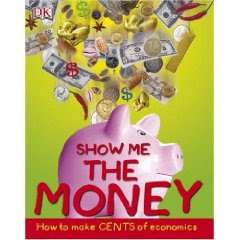From Cowrie Shells to Silver Certificates: Show Me The Money: How to Make Cents of Economics by Alvin Hall
"If you were on a desert island, no amount of money would help you survive--you couldn't eat it, drink it, use it to build a shelter, or to keep away wild animals.
So why is money valuable?
The answer is simply that everyone has agreed to it."
When you think about this last sentence, it seems remarkable that a planet full of diverse and opinionated people like us could agree on such an abstract concept as modern money, or as author Alvin Hall describes it, a medium of exchange, a store of value, and a unit of account. In his Show Me The Money
With this thorny concept out of the way, author Hall goes on to explain in short, pithy text boxes such modern-day money matters as supply and demand, banks, stock exchanges, credit cards, and capitalism. Moving on, he discusses coinage, printing of paper money, counterfeit, and emerging means of exchange, such as debit cards, gift cards, radio frequency identification (RFID) tags, and electronic credits (see PayPal!)
Of course, all this exchanging of forms of moola mean that someone has to actually perform some service or produce something of value in order to receive these rewards, and Hall doesn't slack on his discussion of work and of its anxiety-inducing alternative, investing!
There is much more to money--the choices between spending, stashing, or speculating and the perils of each (being busted, encountering inflation in price and thus deflation of the value of your stash, and the perils of getting the biggest return for your investment.) Although he stops short of explaining credit default swaps and Ponzi schemes, Hall takes the middle reader much further into modern economics than most authors have dared.
Shopping tips--look at what you're spending, not what you're saving by buying on sale; recognize the difference between needs and wants; and comparing the long-term gains and losses from money use--round out the discussions of personal finance. Hall then moves on to discuss matters of international economics, fair trade versus free trade, Keynesian versus Friedmanic philosophy, and the up and down cycles of global business. He even ventures to look at the world of work in 2020, ("The Way We'll Work") when his readers will be becoming part of the world's economy as producers.
Typical of Dorling Kindersley's design style, there are no long chapters, subdividing into sub-subjects, and no long gray blocks of text. Instead, bright photos and graphics dominate every page and subject sections are limited to double-page spreads. Still, Hall manages to cover a lot of ground, hitting the high points of economics and grounding them fairly firmly within the experiences of his intended audience. A brief biographical section, "And the Winners Are..." features current superstars who have taken good ideas and hard work into the realm of riches--Ben & Jerry, Tiger Woods, Bill Gates, Charles Schulz, J.K. Rowling, etc.,-- and a "Who's Who" of economics which briefly cameos theorists such as Adam Smith, Karl Marx, John Maynard Keynes, and Milton Friedman, to name a few. Show Me The Money
Labels: Economics (Grades 5-9), Money



6 Comments:
This book sounds like a pretty good basic book for kids. The only problem is it doesn't seem to mention anything about fractional reserve banking, i.e. how to create money out of thin air. That's the lesson today's kids (and adults) need to understand. Also, a section on the Weimar hyperinflation would be something good to get them up to speed on. I have a feeling they'll need it soon.
By Anonymous, at 11:20 PM
Anonymous, at 11:20 PM
Monetarism is so 30's....where in this "Who's Who" is Hayek? Bastiat?
This book would seem to teach kids the economics of the 20's through the 00's, at least in terms of the "conventional wisdom" that "we are all Keynesians now." But we are living through a change of paradigm. Intentional monetary inflation as a panacea for economic downturn has run its course. Amidst the cries of "the end of Capitalism", few note that Capitalism defiantly stands on the wreckage of a Monetarist debacle.
By cthulhu, at 11:57 PM
cthulhu, at 11:57 PM
A great book explaining inflation, economics etc for kids is, "What Ever Happened to Penny Candy". I HIGHLY recommend it.
By D., at 9:10 AM
D., at 9:10 AM
Check out the video "Money as Debt" (Google it) for a great intro into the history of money and our current fractional reserve system...
By Tommy Sikes, at 4:18 PM
Tommy Sikes, at 4:18 PM
I'm sure these are all important books and concepts, but perhaps they can wait until the kids master fractions and decimals!
By Anonymous, at 9:05 PM
Anonymous, at 9:05 PM
I really appreciate how informative this post is! If you’re searching for “pollo loco near me,” you’ll find fresh flavors waiting on the el pollo loco menu
By strongsite, at 1:07 AM
strongsite, at 1:07 AM
Post a Comment
<< Home